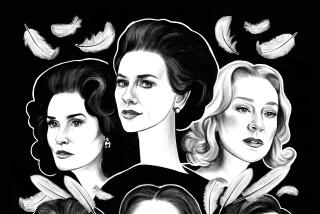Sympathetic Crime King
- Share via
Al Capone fit a lifetime of fame into less than a decade of running the mob in Chicago.
Watching “King of the City,” Robert Gallo’s solo show about America’s most famous crime lord, you realize how Capone remains the template for pop-culture gangsters--to the point that Capone’s own life seems familiar.
Gallo alternates between direct address--for Capone’s thoughts and asides--and telling Capone’s life story through the device of a newspaper interview. The portrait that emerges is primarily sympathetic with undertones of admiration.
In a brief introduction, Gallo successfully sets the tone of the 1920s: the Great Depression hasn’t hit, dance halls are full of flappers and swing bands, Lindbergh is flying across the Atlantic. Hanging over this can-do country, however, are the thou-shall-not laws of Prohibition. So people like Capone were making a fortune selling liquor.
After that, though, the timeline falls apart. Pre-Chicago flashbacks--answers to the reporter’s questions--are easily distinguished. But where later events fall in relation to the interview remains murky. This is particularly frustrating since Capone’s fall so closely parallels the end of the Roaring ‘20s: He was convicted of tax evasion in 1931 and sent off to prison for eight years. The election of Franklin D. Roosevelt the next year meant Prohibition’s days were numbered.
Also problematic are the number of secondary characters who remain thinner than cardboard cut-outs. Clearly the audience is meant to rely on the brief bios of Dion O’Bannion, Lucky Luciano and Bugs Moran.
Gallo certainly looks as movies have taught us a gangster should look: Sicilian coloring, black hair, harsh face, thick eyebrows. (Capone, whose parents came from Naples, looked oddly like Bob Hope.) At times, Gallo is every ounce the Capone you expect after seeing “Little Caesar” and “Scarface.”
But as co-writer, Gallo wants Capone to be likable--too likable. He’s clever, never crass. The script is punctuated with clever one-liners such as, “The American way: If the system doesn’t work for you, work the system,” and “Jesus Christ himself made water into wine--does that make him a bootlegger?” He protests that the St. Valentine’s Day massacre wasn’t his idea.
Gallo wrote the play and then developed it with Juanin Clay, a familiar name in Valley theater circles. Clay directed theater in the area until shortly before her death in 1995, and the Valley Theatre League now gives a lifetime achievement award named after her.
Clay is, however, still the credited director for “King of the City.” She undoubtedly had a great influence on the show when it was first developed in 1991-92. But now, six years later, “King of the City” seems a little lost, a little out of focus, something a new director might have prevented.
The audiocassette used for the sound effects sounded six years old as well, with tape hiss too loud to ignore during critical scenes. While the sound design was effective in concept, it was undermined by the loud clicks of the tape deck in the booth and the audible whir of the slide projector--distractions exacerbated by the fact that the theater is in the flight path of Burbank Airport.
Gallo and Clay also left out one interesting detail about Capone: He died of complications from syphilis in 1947. That certainly would have colored his comments about keeping his prostitutes healthy, not to mention his “decision” to play crazy after his release from prison.
In the end, Gallo’s Capone seems to want to be a hero--not an anti-hero, his more traditional role. As he leaves the stage, he rhetorically asks what were the best times, then mimes playing with his son.
Capone, misunderstood family man? Hard to swallow.
BE THERE
“King of the City: An Evening With Al Capone,” at Bitter Truth and Sweet Lies Theatre, 11050 Magnolia Blvd., North Hollywood. Friday-Saturday, 8 p.m. Ends Feb. 21. $10. (818) 755-7900. Running time: 1 hour, 35 minutes.
More to Read
Only good movies
Get the Indie Focus newsletter, Mark Olsen's weekly guide to the world of cinema.
You may occasionally receive promotional content from the Los Angeles Times.










